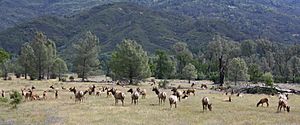Lake Pillsbury facts for kids
Quick facts for kids Lake Pillsbury |
|
|---|---|
 |
|
| Location | Mendocino National Forest Lake County, California |
| Coordinates | 39°24′26″N 122°57′27″W / 39.4072°N 122.9575°W |
| Type | Reservoir |
| Primary inflows | Eel River |
| Primary outflows | Eel River |
| Catchment area | 289 sq mi (750 km2) |
| Basin countries | United States |
| Surface area | 2,000 acres (810 ha) |
| Water volume | 80,500 acre⋅ft (99,300,000 m3) |
| Shore length1 | 65 mi (105 km) |
| Surface elevation | 1,818 ft (554 m) |
| 1 Shore length is not a well-defined measure. | |
Lake Pillsbury is a beautiful lake located in the Mendocino National Forest in Lake County, California. It was created by building a dam on the Eel River. The lake sits about 1,818 ft (554 m) above sea level and has about 65 mi (105 km) of shoreline. It covers an area of over 2,000 acres (810 ha).
Many fun activities are popular at Lake Pillsbury. You can enjoy powerboating, fishing, swimming, sailing, and picnicking. There are also great spots for hiking and even hang gliding! The lake area has many homes, making it a lively place for recreation.
Contents
Discovering Lake Pillsbury's Past
In 1906, a company was formed to bring more electricity to the city of Ukiah. They planned to use the power of the Eel River. First, they built a small dam to send water through a long tunnel. This water then flowed into the Russian River and powered a special building called a powerhouse. This whole project was known as the Potter Valley Project.
Later, another company took over the project. By 1908, water was already flowing to the power plant. The second part of the project was to build a much bigger dam. This dam would create Lake Pillsbury, located about 12 miles (19 km) upstream from the powerhouse.
Building Scott Dam
The main dam, called Scott Dam, was finished in 1921. It's a strong concrete wall, 138 ft (42 m) tall and 805 ft (245 m) long at the top. This dam helps store a huge amount of water, up to 86,400 acre-feet. The stored water ensures that the hydroelectric plant always has enough water to make electricity, even when the river's natural flow is low.
In 1933, Pacific Gas and Electric Company (PG&E) took over the project and still manages it today. The lake was named after one of the people who helped start the Snow Mountain Water and Power Company. The Pillsbury hydroelectric plant is special because it's the only one PG&E operates in this part of California.
Fun Things to Do at Lake Pillsbury
Lake Pillsbury is a popular spot for outdoor adventures! There are five campgrounds where you can set up your tent, plus two larger campgrounds for groups. The lake also has two paved boat ramps, making it easy to get your boat into the water.
Boating and Water Activities
The Lake Pillsbury Resort offers a marina where you can rent boats, find boat slips, and buy supplies. All kinds of boating are allowed on the lake, and you can even camp on your boat!
Fishing Adventures
The California Department of Fish and Game regularly adds trout to the lake, so there are plenty of fish to catch. Other types of fish you might find include black bass, steelhead, and pikeminnow.
It's always a good idea to check local advisories about eating fish from the lake. The California Office of Environmental Health Hazard Assessment (OEHHA) provides information to help you know if the fish are safe to eat.
Exploring Trails
If you love hiking, Lake Pillsbury has some great trails. There's a special nature trail at Sunset Campground that teaches you about the local plants and animals. You can also walk the 4-mile (6.4 km) Lake Shore Loop Trail, which goes around part of the lake. Nearby, you can explore the Snow Mountain Wilderness and the historic Bloody Rock area.
Amazing Wildlife at Lake Pillsbury
Lake Pillsbury is home to some incredible animals, especially the tule elk. These elk are one of the largest land mammals native to California. Female elk can weigh up to 350 pounds, and the largest males can weigh around 500 pounds!
Tule Elk: A Comeback Story
During the California Gold Rush era, tule elk were hunted so much that they almost disappeared. But in the late 1970s, the California Department of Fish and Game brought them back to the Lake Pillsbury area. Since then, their numbers have steadily grown. In 2007, there were about 80 elk living near the lake.
The elk usually live on the north side of the lake, near Hull Mountain. They love to eat wild clovers, grasses, and the green plants that grow around the lake's edges in summer and fall. The Mendocino National Forest is one of only two national forests in California where you can find tule elk. There is a short hunting season for elk each year in September.
Images for kids




